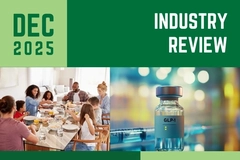
- Industry news
Industry news
Trending now
- Category news
- Reports
Trending now
- Key trends
Trending now
- Multimedia
Multimedia
Trending now
- Journal
- Events
Trending now
- Suppliers
Suppliers
Trending now
- Home
- Industry news
Industry news
Trending now
- Category news
- Reports
Trending now
- Key trends
Trending now
- Multimedia
Multimedia
Trending now
- Events
Trending now
- Suppliers
Suppliers
Trending now
Silent emergency: Aid collapse in Somalia puts children’s lives on the line
Somali children are facing a ticking clock of illness and death, Save the Children warns. The drop in foreign aid is reportedly forcing 121 nutrition centers to shut down by June.
Nutrition Insight speaks to the NGO about how this crisis reflects on the global aid system, while addressing questions of responsibility and what reforms are required to prevent poverty and hunger from echoing across generations.
“It underscores the fragility of the aid system and its reliance on donors — and often government budgetary decisions — overnight this can mean children lose access to life-saving services such as health, nutrition, education and food assistance,” says Save the Children’s humanitarian director, Francesca Sangiorgi.
“These are not just numbers. They are children struggling to survive who depend on aid to do so. It also undermines years of efforts to rebuild lives and lift entire communities out of poverty. Turning our backs on children now should not be an option. More viable, long-term and sustainable solutions need to be sought.”
In addition to the funding loss, the displacement of people due to attacks by armed groups and low rainfall is pushing children into a deeper state of emergency. According to the data from the Food Security and Nutrition Analysis Unit, 1.8 million children will face acute malnutrition and 479,000 will suffer from severe acute malnutrition (SAM).
Climate and displacement impacts
Despite decades of humanitarian and nutrition interventions, Somali children still face deadly hunger.
“Somalia is one of the least contributing countries to climate change, yet one of the most impacted. Cyclical droughts, floods, and cyclones are becoming more frequent and intense — this, combined with conflict, is a recipe for disaster. In 2022, Somalia witnessed the worst drought in 40 years and averted the risk of famine thanks to the scale-up of aid,” explains Sangiorgi.
 Save the Children Humanitarian Director, Francesca Sangiorgi.“By the end of 2023, the worst floods in 100 years hit the country, with devastating consequences. Every time these large-scale natural events occur, people’s ability to cope gets eroded. Now more than ever, countries that have heavily contributed to climate change have the duty to support the most vulnerable being impacted by disasters, especially children.”
Save the Children Humanitarian Director, Francesca Sangiorgi.“By the end of 2023, the worst floods in 100 years hit the country, with devastating consequences. Every time these large-scale natural events occur, people’s ability to cope gets eroded. Now more than ever, countries that have heavily contributed to climate change have the duty to support the most vulnerable being impacted by disasters, especially children.”
According to a recent perspective published in The American Journal of Clinical Nutrition, three million Somalians are displaced due to conflict and are dependent on foreign aid.
“USAID was set to provide US$125 million to Somalia in 2025 for nutrition programs. Without treatment, SAM case fatality rates can reach 50–60% in hospital and famine conditions, whereas well-managed therapeutic feeding programs reduce mortality below 5%,” warn the authors.
“If USAID and humanitarian partners — such as the WHO and WFP, which received US$7.2 billion from the US in 2022 — are unable to mount a full humanitarian response, there could easily be hundreds of thousands of preventable deaths due to SAM children in Sudan and Somalia alone.”
Meanwhile, Fatima, a 25-year-old who fled her village after successive droughts damaged crops and livestock, lives in a displacement camp in Baidoa. Save the Children diagnosed her one-year-old child with severe acute malnutrition.
“If we were not able to get medicines and nutrition support here, we would have no other option but to see our children dying in front of us. There is no other service here, so we would only see our children get progressively worse,” she says.
The NGO warns that this year, 11% more children will be severely malnourished than last year.
Nutrition loss ripples across generations
Sangiorgi shares insights into how loss of nutrition services in Baidoa can ripple through a family, a community, and a generation.
 Fatima’s daughter in Save The Children’s nutrition center.“Proper nutrition is essential in the first 1,000 days of a child’s life to ensure their correct development. When nutrition services in a place like Baidoa close, the impact is huge — children might be stunted, have weaker immune systems, and have delayed development, for example, and the impact will last their entire life.”
Fatima’s daughter in Save The Children’s nutrition center.“Proper nutrition is essential in the first 1,000 days of a child’s life to ensure their correct development. When nutrition services in a place like Baidoa close, the impact is huge — children might be stunted, have weaker immune systems, and have delayed development, for example, and the impact will last their entire life.”
“In 2025, 1.8 million children under five are projected to suffer from acute malnutrition in Somalia — these are numbers we should not be seeing today. The effect also multiplies at the community level, it increases the health burden, weakens the workforce and affects the overall resilience of communities to cope in times of crisis.”
Entire communities face challenges to overcome poverty and extreme vulnerability across generations, according to Sangiorgi.
“Malnutrition today means fewer children thriving tomorrow — and a generation less able to rebuild and lead their communities.”
Political responsibility and structural reforms required
Funding decisions are political. However, the question of who is responsible when a child dies from hunger remains unanswered.
“Ultimately, today’s governments’ decision to cut funding bears a huge responsibility toward it, but the system itself needs to change. We must find more sustainable and longer-term solutions to avoid relying on far-away governments’ decision-making,” says Sangiorgi.
“What is hard to reconcile is that at the end of the day, a decision made in a capital far away from Somalia will impact the lives of vulnerable children here. How can we explain this to the communities we serve when, from one day to another, we can no longer provide vital services? Humanitarian assistance should not become a political tool, every child lost to hunger and preventable diseases is a global failure.”
Sangiorgi also thinks about what is necessary to shift from emergency nutrition programs to lasting food security in Somalia.
“Emergency nutrition programs are a short-term, life-saving solution, but while these are now necessary, climate-sensitive and resilience-building programming needs to take place at the same time — that means investing in climate-smart agriculture, local market systems, and access to water, for example — which Save the Children is doing but not at the scale it’s required.”
 Fatima, holding her daughter at Save the Children health center in Baidoa.“At the same time, investments in social capital are pivotal — health and education infrastructure are the backbone of a healthy society, and we’ve worked for years with the government of Somalia to rebuild these, but until everyone is covered, we cannot stop.”
Fatima, holding her daughter at Save the Children health center in Baidoa.“At the same time, investments in social capital are pivotal — health and education infrastructure are the backbone of a healthy society, and we’ve worked for years with the government of Somalia to rebuild these, but until everyone is covered, we cannot stop.”
Sangiorgi says the workers know the root causes of issues and how to address them. However, she calls for longer-term plans that do not over-rely on politically mediated short-term funding.
Aid to decision making
Alarmed by the drop in global aid, Ismahane Elouafi, executive managing director at CGIAR (Consultative Group on International Agricultural Research), suggests governments use the organization’s tools to make food security decisions.
In his article, Elouafi presents evidence-backed solutions for malnutrition, such as the integration of combined nutrition with human, environmental, and animal health services into one system.
He highlights the benefits of biofortification, noting the success of zinc-enriched wheat in Pakistan. To tackle climate issues, Elouafi states that rural communities and farmers in Guatemala, Senegal, and Zambia are benefiting from bundled climate information services.












